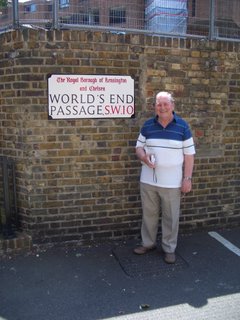Saturday, February 17, 2007
Chelsea Horses


Here's a couple of photos from this month's Chelsea F.C. magazine. The Sunlight Laundry wagon is standing in the Fulham Road, outside the "Bovril" gate into Stamford Bridge. The other picture was taken inside the ground - he seems to be enjoying his hay!
Friday, December 29, 2006
What was in the Cremorne Stereorama . . .
Here's an engraving of the scene depicted in the Stereorama, at the southern end of Ashburnham Hall. It shows a panorama of the route from Switzerland to Italy, via the St. Gothard Pass.


The Cremorne Orchestra
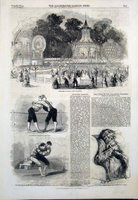

Here, from the Illustrated London News of June 28, 1851, is the Cremorne Gardens Orchestra.
The article is hard to read but includes these lines:
"This popular place of amusement is just now entertaining a large share of public patronage. The Gardens, apart from the variety of entertainment offered to visitors, form in themselves one of the most attractive resorts in the vicinity of the metropolis; indeed, we do not know any pleasure grounds to which the public have access that can be compared with them. Trees centuries old, broad greensward and spacious flower-gardens, interspersed with . . . Grecian art, contribute to make up a scene of exquisite beauty....The park-like character of the grounds makes them a delightful resort for a summer's afternoon."
Isn't this a scene you'd like to climb inside?
Cremorne engravings


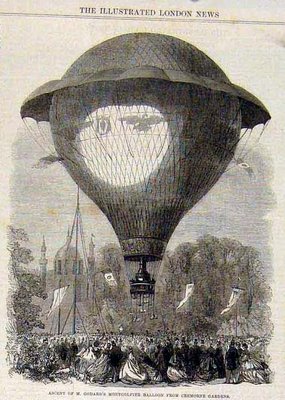
These engravings are part of a collection of pages taken from copies of the Illustrated London News, currently for sale on eBay. They are:
(1) The interior of Ashburnham Hall, showing an exhibition of American plants, 1858
(2) The Maypole, from 1858
(3) The crossing of Madame Genevieve Young "the female Blondini", from Battersea to Cremorne in 1861
(4) The ascent of a Montgolfier hot-air balloon, 1864. This was piloted by a Mr Goddard, who planned to ascend to 5,000 feet but collided with the spire of St. Luke's Church during his ascent and was killed.
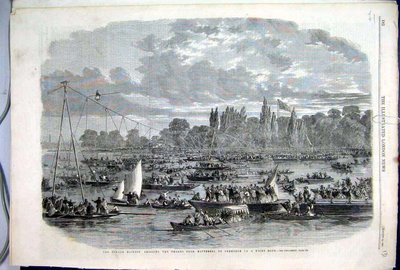
Wednesday, November 29, 2006
Lots Road in Wikipedia
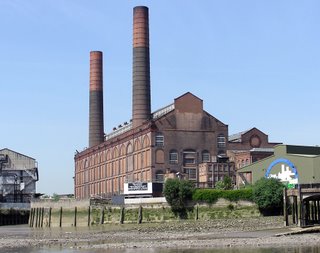
While searching for an image for the previous post, I came across this article, from the German edition of the wonderful Wikipedia online encyclopedia. Readers of Donald's book and his contemporaries from World's End won't miss the irony of this. The English version is here.
News
 I've neglected this blog for a while but I've been spurred into action by an email from Eva, a journalism student, asking for my views on the Lots Road development (see posts below) - I hadn't noticed but it was given the go-ahead earlier this year. It's just struck me that the taller of the two towers is on the Hammersmith side of Chelsea Creek - did the developer think they would be less bothered by the height than RBK&C?
I've neglected this blog for a while but I've been spurred into action by an email from Eva, a journalism student, asking for my views on the Lots Road development (see posts below) - I hadn't noticed but it was given the go-ahead earlier this year. It's just struck me that the taller of the two towers is on the Hammersmith side of Chelsea Creek - did the developer think they would be less bothered by the height than RBK&C?Sunday, March 26, 2006
Stamford Bridge today
Here's Dennis at the Bridge for his early birthday treat, the FA Cup quarter-final against Newcastle United.

This is the view from the new West Stand, which has padded seats and gas heaters to keep the punters warm. A far cry from the uncovered concrete terracing which formed this side of the old stadium.
keep the punters warm. A far cry from the uncovered concrete terracing which formed this side of the old stadium.

This is the view from the new West Stand, which has padded seats and gas heaters to
 keep the punters warm. A far cry from the uncovered concrete terracing which formed this side of the old stadium.
keep the punters warm. A far cry from the uncovered concrete terracing which formed this side of the old stadium.Stamford Bridge Stadium, 31st August 1946
 The queue for the turnstiles at Stamford Bridge, for Chelsea's first game of the 1946/7 season, against Bolton Wanderers.
The queue for the turnstiles at Stamford Bridge, for Chelsea's first game of the 1946/7 season, against Bolton Wanderers.This view is looking out towards the main entrance and the Fulham Road. The crowd, on an evidently wet day, was 61,000. The advertisements are for greyhound racing, something called roller speedway at Harringay Arena and for trains from Walham Green (Fulham Broadway, see below).
Tuesday, February 28, 2006
More about the Cinema
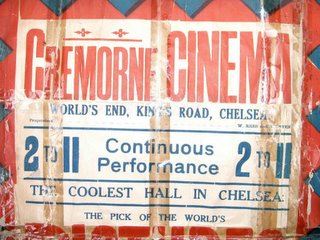 Some more information from Dad:
Some more information from Dad:"I remember the Sally Army building, it was next to the passage by the pub. I remember the soup kitchen, it became my job after to go and collect a jug full for a penny. I vaguely remember seeing slide shows there but I think that was after the Sally Army took it over. The soup was very welcome once a week when the money and food run out. I think the slogan was right up to date 'the coolest hall in Chelsea'."
If you blow the image up, you can read the Proprietor's names, "W. Rees and S.Leven" Does anyone remember who they were? Perhaps one was the fearsome character Uncle Bob desribes. It would be interesting to know whether they had a connection with the Cremorne Gardens or other Chelsea enterprises.
The Cremorne Cinema

Uncle Bob has scanned this priceless artifact for us, I will let him provide the description:
"Gary, I know you will be more than interested in this very old Poster. I have had it many years but can't remember how it came into my possesion. Its age can only be guessed at. I can well remember going there on a Saturday morning when it was only for kids. After you bought your ticket you walked through a Curtain and immediately on your right, on a brick wall was the film!. A man who frightened us to death keept us in good order. Apart from the usual Cowboys, one film I well remember was Gorden Harker, a well known actor of the day, he played the part of a police inspector, after a Gang who all had a Frog tattooed on their arm, so the film was called "The Mark of The Frog". This went on for many weeks so we had to go every saturday, in the end the Gang leader proved to be . . . Gorden Harker !!!
Long befor the War started the Cinema closed down and became, without much alteration, the Salvation Army Citidel. Many a Saturday I was sent there with a big jug for a penny worth of soup which was full of meat and helped to fill our bellies.
Ah me, those were the days."
Friday, February 17, 2006
More Pictures

Our Uncle Bob, Robert Hartwell, has scanned in these photos from his album. The centre and right-hand pictures were taken outside Guinness Trust. Click on the image for a bigger version and to read the captions.
Monday, January 23, 2006
Fulham Broadway Station and Joe Lyons

Also from the Museum of London library, a memory jerker for fans of Chelsea FC. This grand facade has been swept away to make way for a shopping centre. The station was called Walham Green (the proper name for this area) until 1952.
Cheyne Walk by Moonlight, c.1850

The Museum of London Web site has a searchable database of its picture library. It's here, but be warned, you'd better take the phone off the hook and make a cuppa before you sit down in front of it! Here's a picture of how Cheyne Walk looked before Battersea Bridge was built.
Description: 'Cheyne Walk in Chelsea, by Moonlight', c1850. A full moon shines over the River Thames, with boats at low tide. On the left is Chelsea Old Church, with two Chelsea pensioners standing by the monument to Sir Hans Sloane whose collections are the foundation of the British Museum. This image predates the construction of Battersea Bridge, completed in 1874.
Thursday, December 29, 2005
The Hartwell Boys
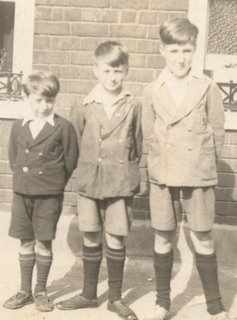
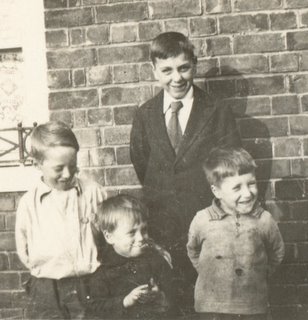
These are a couple of photos from the family album, of the Hartwell boys at Guinness Trust Buildings. First pic, l to r: Joe, Den and Stan. Second, l to r: Bob, Den, Cecil and Joe.
More World's End Photos
Wednesday, June 29, 2005
World's End Pilgrimage

On the 19th June, we had a family pilgrimage to Chelsea. Here is Dennis, brother of Stan Hartwell, outside No.4 Guinness Trust Buildings.
You can see more photos from our trip here.
Wednesday, June 08, 2005
More Photos
This site has a series of photographs of the power station.
Monday, June 06, 2005
Before there was a World's End

The Thames at Battersea by David Cox, 1824. If you want to see the original, it's in the National Gallery of Art in Washington D.C.
Saturday, June 04, 2005
A conundrum . . .
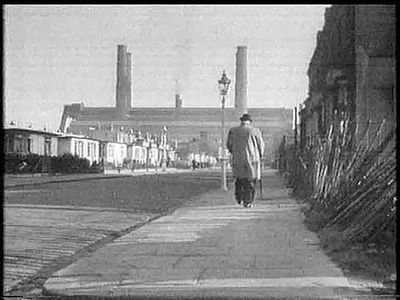
This is a frame from the 1952 Ealing Studios film "I Believe in You". That's Cecil Parker walking toward what is obviously Lots Road, but which street is it? And aren't those prefabs?
Lots Road by Night

The Power Station, 26 November 1931. The two chimneys on the Lots Road side of the plant were removed in the 1960s. From the Daily Herald Archive/Science & Society Picture Library.
Cremorne Gates
A small public park between Chelsea Wharf and the Chelsea Yacht & Boat Co., south of Lots Road, is the only remnant of the original Cremorne Gardens. Looking unfeasably grand in these ordinary surroundings are . . . 
a set of original gates from the park.

a set of original gates from the park.

Here's the Council plaque adjacent to the gates. Eight tonnes of cast iron, no less. Looking at the map it would appear that there were more than one set of these gates at the King's Road entrance to the park.
The Power Station

Taken from the junction of Uverdale Road and Burnaby Street. It's obvious from this view that any kind of attack on the Station would have threatened those living in its shadow.
Chelsea Creek

Taken from the bridge leading to the Chelsea Harbour development. Chelsea Creek is the mouth of Counter's Creek, a buried stream which rises in Kensal Green. The Creek forms the boundary between the Boroughs of Hammersmith & Fulham and Kensington & Chelsea. The West London and District Line railway was built over its former bed and the bridge carrying Fulham Road over the Creek gave its name to Stamford Bridge Stadium.
Wednesday, May 18, 2005
Another People's War post
Gerald Atkinson went to St. Marks and lived in Hortensia Road. Here's his post on the BBC People's War site.
Saturday, May 14, 2005
From Middlesex Past Web Site
More facts about Chelsea, including its geology ("Kempton Park gravel over London clay"). Interestingly the population in 1991 was half that of 1901.
Terry Farrell Partnership - architect, Lots Road development
"TFP’s objective is to unify an important but fractured district of London with physical, social and visual permeability" - apparently
Friday, May 13, 2005
Stamford Bridge Stadium

The Stadium from the Fulham Road. The banked terracing was built using spoil from the construction of the London Underground. The wall in the left foreground is the only part of the old stadium still in existence.
Thursday, May 12, 2005
BBC People's War - Chelsea Stories
Results of a search on "Chelsea". Includes an entry by Stephen Fletcher, son of Agnes Fletcher (Rogers) who lost her parents, Walter and Agnes in the bombing of the Guinness Trust flats. He mentions a memorial in Morden Cemetery to the victims.
Chelsea in the Thirties

A page from a 1930's A to Z of London, showing the World's End and the surrounding area. Click on the map for a bigger version (may be slow!)
The History of Chelsea - Online
This is an online version of the Chelsea volume of the Victoria History of Middlesex, as available from booksellers Boydell and Brewer at a cool 95 quid(!). It is a detailed study of the area from Anglo-Saxon times to 2002.
Inside the Power Station
This article, by David St George of the Hampstead Scientific Society (no less) describes Lots Road power station in exhaustive detail. Interesting facts about the plant; when it was opened, in 1905, it was the largest electricity generating station in the World and the first to power a railway. At the time of its closure, in November 2002, it was the oldest.
Cremorne Gardens

Donald devotes several pages to the extraordinary Cremorne Gardens, a pleasure park by day and apparent den of iniquity by night, which occupied the site on which the Guinness Trust development was built. This map shows the size of the park (from the King's Road to the River), as well as some of its attractions. Race you to the "Stereorama".
Lots Road Power Station
In his book, Donald mentions plans to demolish Lots Road power station. A development consortium has submitted plans for a £500M redevelopment of the Power Station and the Chelsea Creek area. This scheme retains the shell of the powerhouse but adds two huge high rises either side of Chelsea Creek and nine smaller residential blocks. The locals are up in arms
